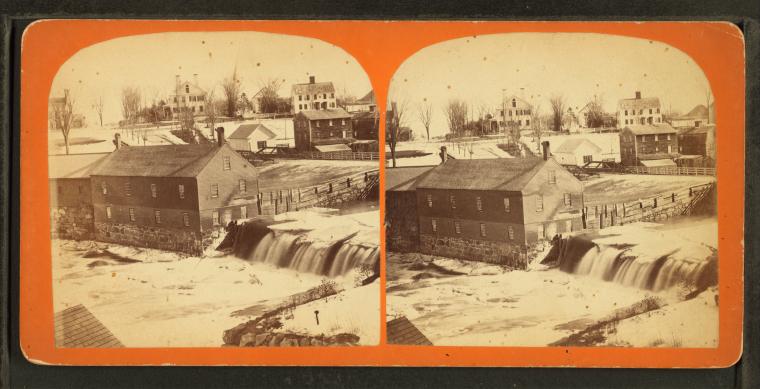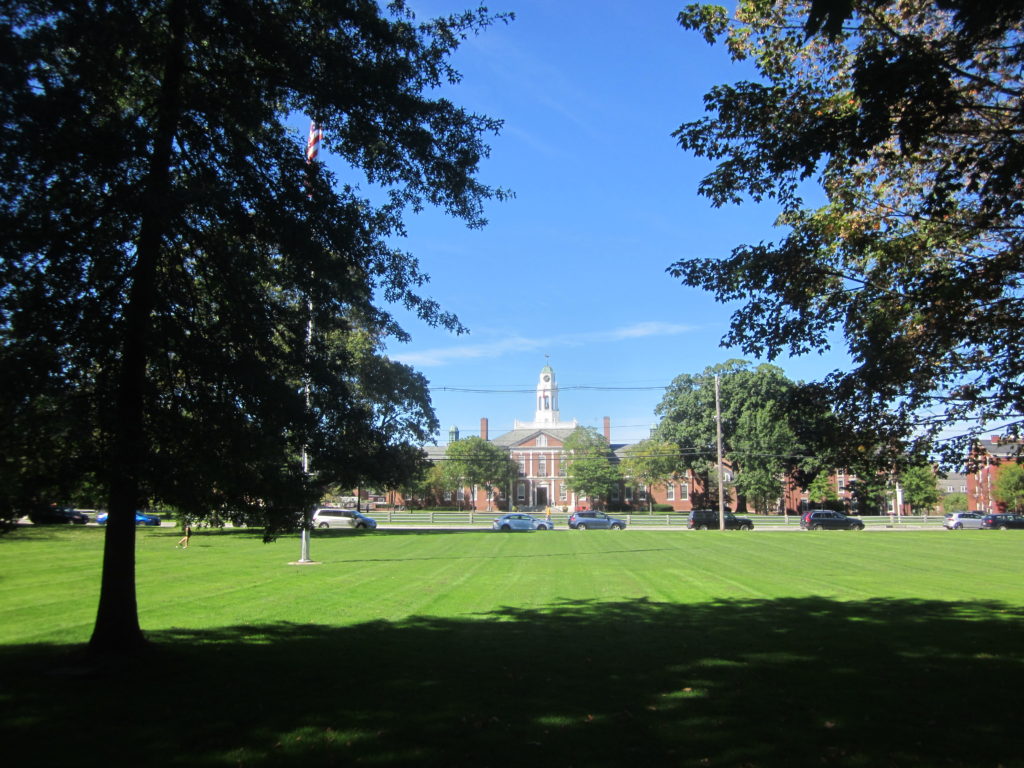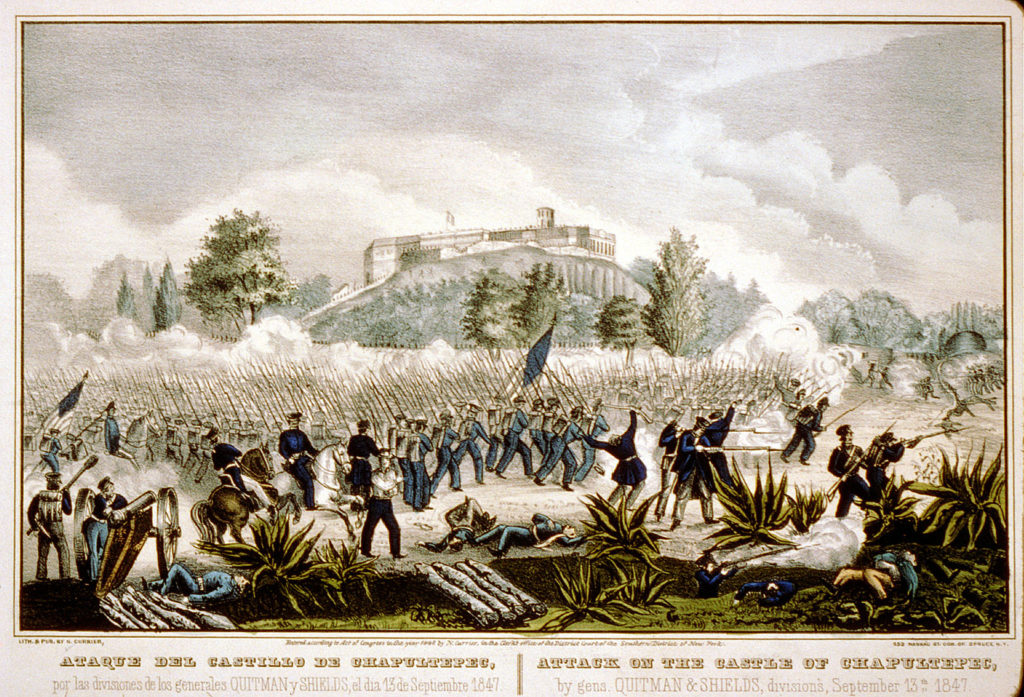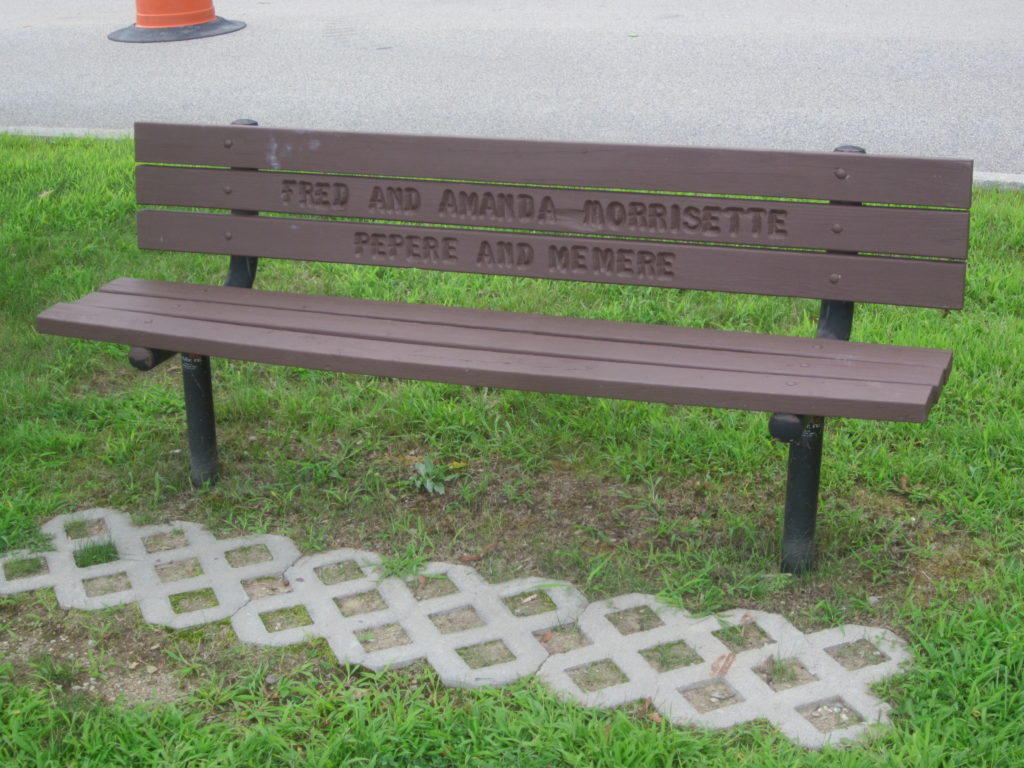Much has been made of unconventional Franco-American experiences and stories, on this blog. (See here, here, and here, for instance.) Franco-Americans living in rural parts of New England and New York State are perpetually in the shadow of those who settled in industrial cities and worked in factories. A similar neglect is apparent when it comes to French Canadians who moved to Northeastern towns that did not have a national parish, cultural societies, a French-language newspaper, textile factories, and so forth. Yet, as we begin looking beyond the Little Canadas, we find fascinating stories that add complexity to conventional narratives.
Exeter, New Hampshire, is a perfect example. The town has many claims to fame as the site of revivalist George Whitefield’s last sermon, the state capital during the revolutionary era, the birthplace of general and political figure Lewis Cass, and the home of Phillips Exeter Academy, notably attended by Daniel Webster, Franklin Pierce, John P. Hale, and Robert Todd Lincoln. In addition, the local museum holds one of the few surviving “original” copies (a Dunlap broadside) of the Declaration of Independence.
But, like nearby Newmarket, in the Seacoast region of New Hampshire, Exeter’s French-Canadian history has garnered little attention.
Local historian Barbara Rimkunas has traced some of that history. She explains that these Canadians really became a considerable presence in the 1880s, during the town’s industrial boom. (Chalk this one up to the conventional narrative!) But how far back in time ought we to go to find the origins of that movement?

By the mid-1840s, some of the first seeds of later Franco communities were planted. Just as Thoreau was chatting up Alex Therrien near Walden, Antoine Lorraine settled in Charlotte, Vermont, while Charles Fortier and Israel Shevenell went to Old Town and Biddeford, Maine. Exeter soon had its own “seed.” Pie Narcisse Legendre appeared in town in the same period—more than thirty years before the large influx of the 1880s.
Many young men who crossed the border in the 1840s effectively had little to lose by seeking opportunities elsewhere. We may wonder whether this was true of Legendre. He was born in Lotbinière, located between Trois-Rivières and Quebec City, on the southern bank of the St. Lawrence River, in 1822. His father was a surveyor and militia captain who had served a term in Lower Canada’s legislative assembly, suggesting some social prestige. But Pie Narcisse also had two older brothers, whose place in life had to be assured. The family may, in addition, have faced some reversals in the 1830s. Now a lieutenant colonel of the militia, the father, Louis, seems to have thrown his lot with the loyal forces during the Rebellion of 1837. Although Lotbinière was hardly a hotbed of revolutionary activity—as parishes along the Richelieu River were—the elder Legendre’s views likely won him few friends. From a cynical perspective, there is no sign that his identification with the British colonial regime translated into new opportunities or greater status for the family.
How Pie Narcisse found his way to southern New Hampshire in his early or mid-twenties is still anyone’s guess. Evidently, he was a young man of talent and ambition; he was also adventurous. For a year and a half, he studied law in the office of James Bell and Amos Tuck. It seems he supported himself in part by teaching French, although not at Phillips Exeter, which only appointed an instructor in a modern language (which was French) in 1868. He may have taught the ladies of the Female Academy, where Tuck was a trustee for a time.

The world continued to expand for Legendre. Around the time Bell left Exeter, Americans were at war—not with Britain, as some might have anticipated, but with Mexico. Border skirmishes followed the annexation of Texas, until the United States Congress declared war on May 13, 1846. Legendre dropped, for the moment, the prospect of a comfortable, professional life in eastern New England. Inspired perhaps by his father, the militia officer, he enrolled in the U.S. Army.
The actual record of Legendre’s enlistment has yet to be found. The little we know of his wartime experience comes from a letter to the Exeter News-Letter published on his return, in the summer of 1848. A correspondent wrote:
[Captain Legendre] was in the battles of Cerro Gordo, San Antonio, Cherubusco and Molino del Rey – in the latter of which [in September 1847] he was wounded with a large musket ball. The ball entered the breast near the right side of the right lung – passed through a portion of the lung under the clavicle and was cut out from the back between the shoulders. In the battle in which he was wounded he was one of the small band of men who were selected, for their courage, to compose the assaulting column at Molino del Rey, where five hundred Americans put to flight six thousand Mexicans – about four hundred out of the five hundred were either killed or wounded.
Legendre did not merely escape near death in battle; he also survived the poor sanitary conditions and cholera outbreak that decimated part of the U.S. Army. And, while generally few Canadian-born men joined the fight, his decision to enlist mirrored the significant presence of migrants in the ranks. It may be that as many as 50 percent of General Zachary Taylor’s troops were foreign-born—many facing nativism and anti-Catholic prejudice along the way.

There seems to have been little of that when Legendre—whose unusual first name was also the Pope’s—returned to Exeter, after the end of hostilities. In fact, the correspondent who shared news of the young Canadian’s exploits also noted the hero’s welcome that awaited him. A delegation of prominent men expressed their esteem in a letter dated July 16, 1848:
We are happy to have again in our midst one whom we respect, and have reason to respect as a soldier, a man and a citizen . . . You have shown to us, and to the world, that you have the will and the courage to obey, when your adopted country calls, and that you can cheerfully volunteer your energies in assisting to guard that precious tree of liberty which our fathers planted and whose fruits we gather in such rich clusters. You deserve the honor and sympathy of all good citizens.
As with other immigrants in many wars yet to come, military service enabled Legendre to assert his devotion to his adoptive country—he could be acknowledged as a patriotic American, whatever his background. And so he was: the authors invited Legendre to a banquet in his honor at a local hotel. He declined, while sincerely thanking them:
[I]t is true that I have assisted in carrying our country’s glorious flag over the strong battlements of Mexican fortresses, and the proud palace of the Montezumas, and that my blood has mingled with that of many of the United States’ most devoted sons; but having been but an atom in the army, having served in a humble capacity, I could not have rendered such services as would make me deserve the distinguished honor which you wish to confer upon me.
News of these honors no doubt filtered northward to his parents, for, the following month, the Journal de Québec expressed pride in Lower Canada’s distinguished expatriate.
The rest of Legendre’s story remains obscure. He married Bedelia Myhan, possibly also a native of Canada, in Lawrence, Massachusetts, in September 1848. He was then listed as a lawyer. He may be the same Legendre who appears as an attorney in Aroostook County, in northern Maine, in 1850. But his combat days were not over. A Pierce N. LeGendre enlisted in the U.S. Army near New York City in the fall of 1862, a trying time for the Union during the Civil War. Pius N. LeGender joined New York’s 13th Cavalry Regiment as a private the following February. These are likely all the same individual—one who had left Exeter nearly fifteen years earlier and again stood, self-sacrificing, for the Great Republic.
Legendre rode into battle and into the fog of history. But he was undoubtedly present in the minds of his older brother Aubert and sister-in-law Lucie as they left their plot of land in Lotbinière, crossed the border, and settled in Lawrence in the 1870s.
By then, the next phase of the French-Canadian mass migration was well under way, obeying more closely the conventional narrative developed by historians. It is, of course, easy to forget how much these post-Civil War migrants owed to earlier travelers (indeed, adventurers!) who, petit à petit, prepared the ground from which communities eventually sprang. The young man with the name of a Pope and the heart of a warrior was one of those figures who continue to defy our narratives.[1]

My thanks to Barbara Rimkunas, curator of the Exeter Historical Society, and Thomas Wharton, assistant archivist at Phillips Exeter Academy, who were willing to help trace Legendre’s story. Information concerning the Legendre family was retrieved on Ancestry.com in particular. See also, on Exeter history, this book excerpt and this full book from the late nineteenth century.
[1] Those who followed Legendre in Exeter included Edward Franchot, a Quebec native who became editor of the The Exonian at the end of the nineteenth century, and Edward Daignault, a barber to students and faculty with a shop on Water Street who died in 1943.
Leave a Reply